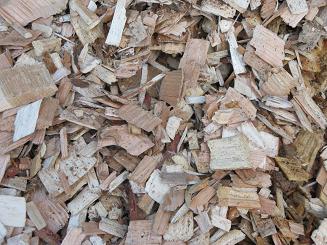by Oladiran Fasin
As part of preparing biomass for conversion into biofuels, biomass is ground through mills such as a hammer mill (Figure 1) or a knife mill. The ground biomass particles are then fed into conversion vessels and/or stored in hoppers that are often attached to storage vessels (Figure 2). Creating a steady flow of the biomass particles out of the hopper is a significant issue for processing and conversion. Often, biomass flow from storage containers will be disrupted by bottlenecks caused by “ratholing” and “arching”. Ratholing occurs when a vertical flow channel develops above the hopper opening of a storage vessel. Research on loblolly pine wood that is ground up indicates that flow problems start when particle size is less than 1.40 mm. This may not be the case for all feedstocks and is driven by the conversion process the feedstock is subjected too.When this channel empties out (because of high cohesive strength of the solid particles), it is referred to as a stable pipe. Arching is a blockage at the outlet of a hopper that is capable of supporting and preventing the discharge of the storage vessel content. Arching can result from high cohesive strength or mechanical interlocking of the particles. Mechanical interlocking occurs when biomass particles are large relative to the outlet opening.

Several studies have shown that particle size of biomass plays a critical role in the “flowability” of the material. Flowability or flow index categorizes the collective impact of bulk flow properties on the discharge of materials from storage vessels. Materials with a flow index greater than 10 are considered free flowing. Bulk flow properties typically include: a) angle of internal friction, b) angle of wall friction and c) cohesive strength. The angles of internal friction and wall friction respectively indicate the friction between solid particles flowing against each other, and the friction between solid particles and the wall of the storage vessel. Cohesive strength is a measure of the force of attraction or bonding tendency between particles of a bulk material. Those with a flow index between 4 and 10 are considered easy flowing materials. Materials with a flow index between 2 and 4 are cohesive, while those with a flow index less than 2 are very cohesive (meaning that they stick together).

In a recent study conducted through the IBSS project, researchers quantified the effect of particle size on the flowability of the ground biomass. Scientists separated ground loblolly pine wood chips fractionate into six typical ground biomass categories (using six screens that have openings between 0.25 mm and 4.17 mm). Following this, powder flow equipment (Brookfield Powder Flow Tester) was utilized to measure the different bulk flow properties of angle of internal friction, angle of wall friction, and cohesive strength. These flow properties were used to calculate the flow index. The flow index results from this study revealed a direct positive correlation between particle size and ease of flow. The results of this study support the conclusions that have been generally accepted across industry; smaller particles of ground biomass play a significant role in decreasing the flowability of the biomass out of the storage container. Small particles are always a product of the grinding process. Removing these particles may be a solution but their removal has to be balanced with a loss of material to be converted into fuels and chemicals.
The next step in this component of the IBSS project is to calculate the threshold percentages of small and large particles which would not drastically affect the flow properties of ground biomass. This aspect of the research project will be important in achieving the overall goal of developing novel systems for biomass grinding. Another opportunity for research includes experimenting with different wall linings of the feeder interface to remove stagnant materials from the vessel and flow inserts.
